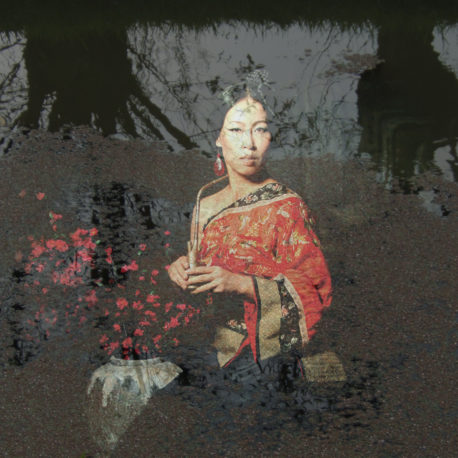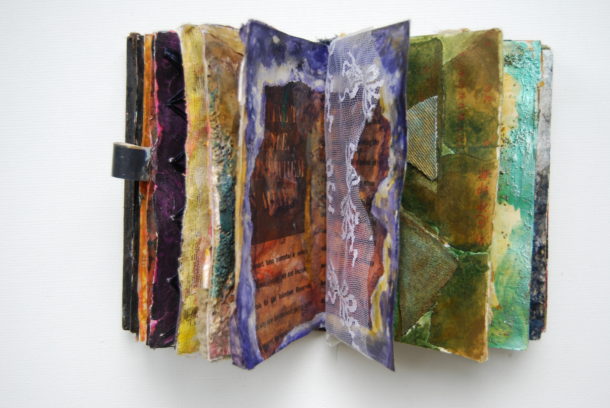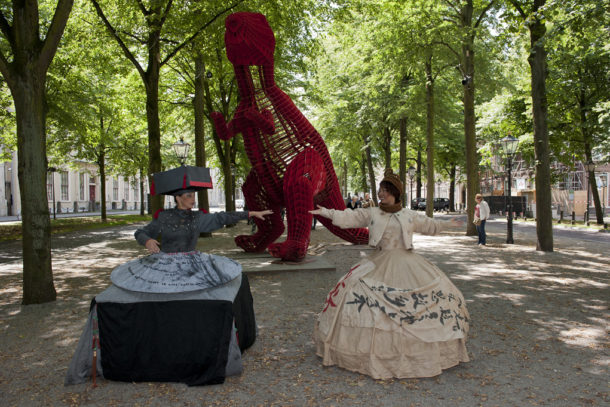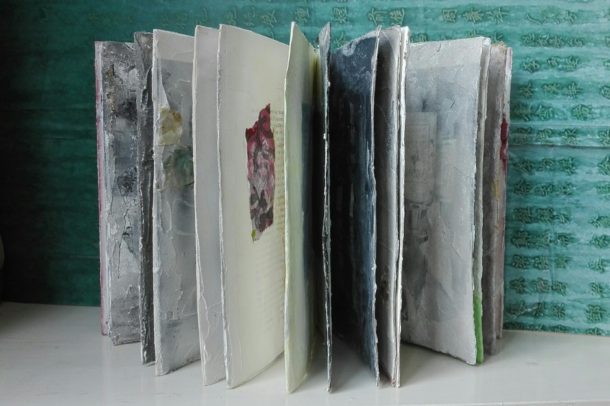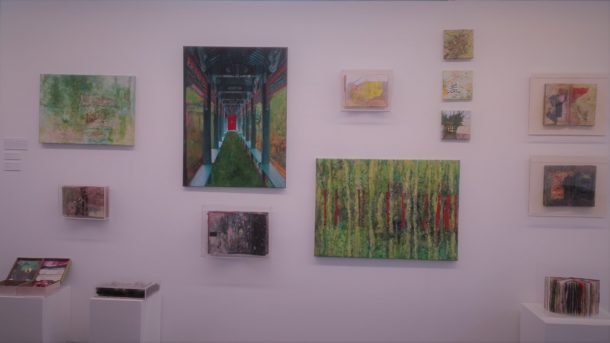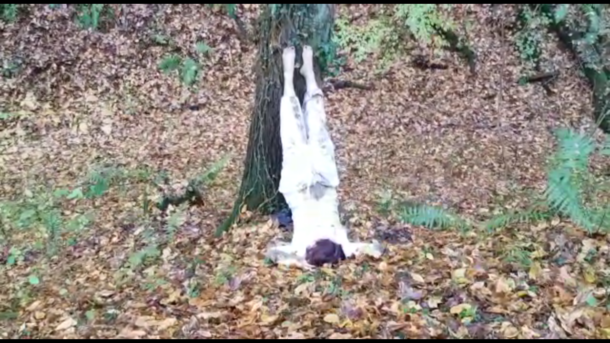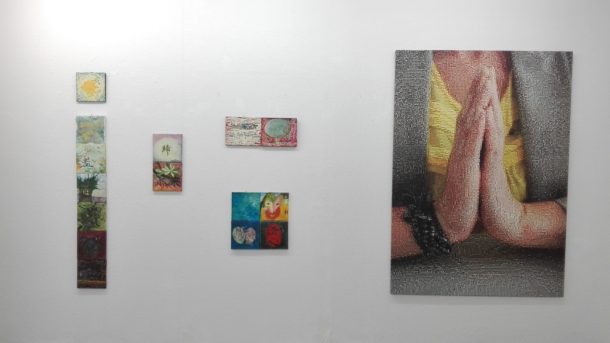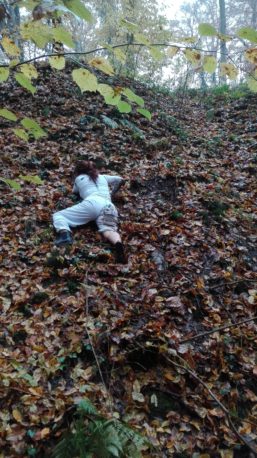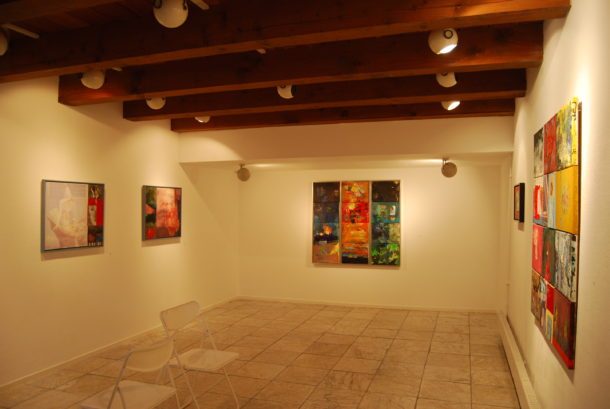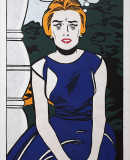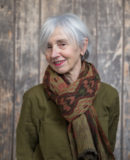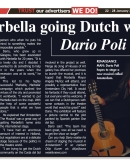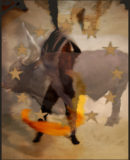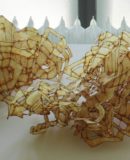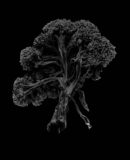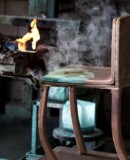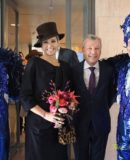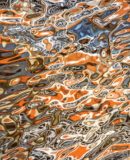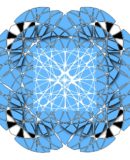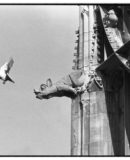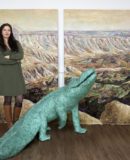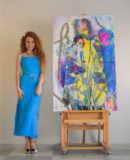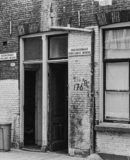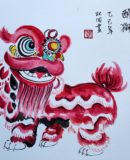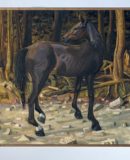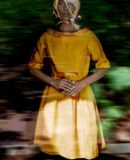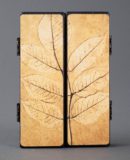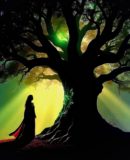World Fine Art Professionals and their Key-Pieces, 160 - Zhanhong Liao
World Fine Art Professionals and their Key-Pieces, 160 – Zhanhong Liao
I saw works by Zhanhong Liao hanging at the Rooting In between exhibition of the Foundation Kunstwerkt in Schiedam. It was the second part of the ‘Rooting project’ that was started in 2016 in Remagen, Germany. The traveling art project is intended as a creative connection between artists from different countries and different backgrounds who together explore the theme. Zhanhong was also the curator.
There were some diaries from Zhanhong, a few paintings and a video, in which we see Zhanhong trying to reach a tree on a steep mountain slope full of fallen leaves. I speak to Zhanghong about her work in Café Engels at the Stationsplein in Rotterdam.
Creativity lessons
Zhanhong comes from a normal family, as she says, in Guangzhou. Her mother was a teacher and her father was in business as a manager of a company. Both were intellectually oriented. She grew up very protected and was obedient as expected, she says. She also participated in the Cultural Revolution at a young age. Her mother, as ‘representative of the possessing class’, had to spend some time in the countryside. “It was a troubled time. My parents were quite tense, even afterwards. It was difficult for them to show love for their children, myself and my younger brother, but yet they did.” Zhanhong did what her parents asked and practiced Chinese calligraphy in her spare time, but she longed deep inside always for independence. She wanted to develop herself.
Zhanhong loved the creativity lessons. “I did a lot of dance at school. In China you can see all kinds of dance: Chinese dance, Japanese dance, Korean dance. We also performed those dances at school. For every dance a new costume. That was so colorful! I have great memories. “And she took painting lessons from a private tutor, where she met her husband. She was very curious about what the rest of the world looked like. In 1989 she got the chance to study art in England. During this study she grabbed the freedom with both hands. She often traveled on her own from England to all kinds of countries during the holiday season. Among others she went to Italy, France, the Netherlands, Germany, Greece and the US. She loved it all.
Once graduated, she crossed the North Sea and came to the Netherlands where her husband lived. It was 1996. “It was an uncertain and beautiful period. We shared a flat with two others, in Vlaardingen, near Rotterdam. In that small space I had to express my feelings in some way. I did that by meditating and by making diaries. It is an investigative report of what I experienced.” It was pure and although there were no commercial thoughts, her diaries were quickly warmly received by the art world. She exhibited in many galleries throughout the Netherlands. She is grateful to receive a Basic stipend from the Fine Arts Fund in the beginning of her artistry.
‘Made in China’ project
She and her husband received a residence permit on condition that they could earn their own income. They went to teach and of course make artworks. They had two children, boys. Her husband was homesick for China and in 2005 he chose to go back to China. “I was with two boys, both young. I had taken my standards and values to be a good woman, but now I had to do it alone. However difficult it was, I realized more and more that it was also a chance for me to grow after the divorce. Who did I want to be? “
Although she experienced a great contrast between Chinese and Dutch culture – “I found that directness very difficult” – nevertheless more and more of the Dutch culture seeped in. “Chinese tell everything with ‘a detour’. Now I sometimes think ‘Pity of the detour’.” She saw that the image of China and the Chinese was sometimes negative, ‘You with your cheap products’. She picked up all courage in 2006 and started the confrontation with the project ‘Made in China’. It was an interactive project, in which she was not afraid to show her own vulnerability. ‘Dare to look at China’ was her challenge to people who saw pictures of China with a story. “There were so many stereotypes. I wanted to raise the question.”
The theme of her art is identity, she says. “My work is very close to my personal life. In a number of works, also performed in dance, circles and squares can be seen. “The circles represent society, the square is me. I have now passed fifty, half of that time I spent in China, the other half in Europe. How European have I become?” In other work she does morphing, the gradual overflow of one image into another, inter alia, the face of Christel from Germany flows into the face of Zhanhong. For many years she worked together with the gallery Josien Bokhoven at the Prinsengracht in Amsterdam. In addition, she has been a member of The Hague Pulchri society since 1999, where she held a solo exhibition every 2/3 year. In Foundation Kunstwerkt from Schiedam she gets the opportunity to also make exhibitions as curator and artist.
Dutch life
She shows pictures of folded hands, the eastern prayer posture. The mosaics in the background are from the submissions of the ‘Made in China’ project. This series of photos came in 1.70 x 1.20 meters, on canvas. “My message was: the West and the East must meet with a respectful attitude.” She experienced the reactions as a helping hand to make more projects in line with this, calling on the municipalities and funds for funding. And she got that support.
“I want more than just being busy with myself,” she says. “I also want to contribute to society. Many Chinese in the Netherlands live in their own world, I often hear. I am one of the exceptions. I do not think about myself: ‘I am a Chinese’, no, I think ‘I am a person’. If I have a problem, I, like the Dutch, seek help. I had questions about the upbringing here and the role of the mother in upbringing. I went to social work and I ended up in discussion groups on this subject. We talk about culture, about religion, including Islam. Our faith is not as certain as that of Islam. But I am not in Chinese society, I am daily in Dutch life. So much so that I can not exactly gauge how big the problem of the Chinese is that linger in their own world. “
She does not really worry about that anymore. “I am happy with the enrichment of cultures in the Netherlands. Now I feel happy, more balanced and grateful for what I have. A beautiful inner self and harmony with my environment is the greatest art. I learn from my mistakes, have been awakened by Pfeiffer’s disease. I started to do yoga and I am interested in Argentine tango lessons. Art symposiums and Artist in Residencies I do with pleasure, I get good feedback from colleagues from different countries and other cultures. During my travels I meet many people, there I get energy of.” In various mediums, Zhanhong expresses her quest for identity, which revolves around her functioning in society and her deep desire as a person to play a good role. She expresses it in painting, photography, performance, social projects and foreign art exchanges. “Everything is connected to each other. What we have learned, what we are interested in, what we have experienced in life, what our values are, what kind of person we are becoming: all that can be found in the artworks. “
Taoism
She also wanted to prove herself for her parents, that she could, after the divorce with her husband, grub it anyway. “I had a lot of ‘urge’. I now have more peace, I take things that come my way. Another mindset than before. I see in the mirror how relaxed I am. I am happy about that. When I teach adults, I notice that I have also become wiser. I have more people knowledge and compassion, what can I do best for different people? I improvise more, I think it’s nice to ‘play’. Understanding is two-way traffic.” She also learned to give more compliments, also to her two boys, now 17 and 14 years old. “In China, a child must be perfect, but the importance of a warm bond is often forgotten.” The bond with her parents, now 77 years old, is also good despite the fact that there are always differences. “It was a good training in not being bitter, rather staying calm and keeping your own course, and forgiving.” The video work in the exhibition reflected on life and staying in touch with nature and her inner self.
The Rooting In between exhibition was concluded with tango dancers including Zhanhong herself, who swirled through the artworks. “This is how we connect the works with each other. The Argentine tango shows who you are, and what your passion is. We do not please people. That corresponds to Taoism. In that philosophy you do not strive for success. Art is only a part of life. Everyone has a different assignment in life. I am healthy, enjoy life and I love my environment. And I inspire people. Keep on developing makes you happy. “
Images: Identity II, 50 x 50 cm, digital work, 2) Detail of Diary, Memory 2, Mixed Media, 1996, 3) Performance West Meet East, Pulchri Studio The Hague, 4) Diary Reflection A4, 2016, 5) Rooting In between, 2017, 6) Rooting Germany, 2016, 7) Exhibition Rooting in Germany, 2016, 8) Video work Rooting Germany, 2016, 9) Solo in Gallery Josine Bokhoven, 10) Dialogues, 2016
http://www.liaozhanhong.com/
https://bit.ly/2IofUii
https://bit.ly/2GwqIi4
https://ifthenisnow.eu/nl/verhalen/de-wereld-van-de-rotterdamse-kunstenaar-35-zhanhong-liao
Disclaimer: The views, opinions and positions expressed within this guest article are those of the author Walter van Teeffelen alone and do not represent those of the Marbella Marbella website. The accuracy, completeness and validity of any statements made within this article are not guaranteed. We accept no liability for any errors, omissions or representations. The copyright of this content belongs to Walter van Teeffelen and any liability with regards to infringement of intellectual property rights remains with the author.

